Annual Report 2019-2020 on Workplace Harassment
Harassment Centre of Expertise (HCE), Employment and Social Development Canada (ESDC)
Message from ESDC’s Deputy Ministers
ESDC is committed to providing employees with a work environment where they feel welcome, respected and safe and where harassment has no place. With a workforce of over 29,000 people, we are not immune to harassment. Preventing, managing and resolving these situations requires constant and ongoing effort. This is a priority for us as your Deputy Ministers.
Graham Flack
Deputy Minister of Employment and Social Development
Chantal Maheu
Deputy Minister of Labour
Benoît Robidoux
Associate Deputy Minister of Employment and Social Development
Lori MacDonald
Senior Associate Deputy Minister of Employment and Social Development and Chief Operating Officer for Service Canada
Message from the ESDC Designated Official for Harassment Prevention and Resolution
As the department's Designated Official, my role is to oversee the application of the Policy on Harassment Prevention and Resolution and the Directive on the Harassment Complaint Process. Through the Harassment Centre of Expertise (HCE), I also ensure that all incidents are managed in a timely, sensitive, fair and discreet manner. This report contains a summary of key activities undertaken in 2019-2020 to support ESDC employees. I firmly believe that everyone plays a role in preventing and resolving harassment and that, together, we can make our workplace all that we want it to be.
Danièle Besner
Director General, Workplace Management Directorate
Prevention and communication
We know that unless uncivil behaviour is managed, situations can escalate. Therefore, ongoing efforts are made to help managers and employees recognize, prevent and address the full range of unacceptable behaviours, from incivility to workplace harassment and violence.
Harassment prevention and awareness campaign
The HCE continues its prevention efforts through the national "Speak Up" campaign. Launched in 2018-2019, the campaign's objectives remain the same:
- educate employees and managers about what harassment in the workplace is and is not;
- urge them to take action if they experience or witness harassment
- inform them about the different options available; and
- encourage them to promote a respectful work environment.
Products, activities, tools and resources developed in 2019-2020:
- Intranet content
- Self-assessment questionnaire
- Corporate emails and messages
- Podcast series
- HCE Services pamphlet
- Intersection articles
- Poster on subltle forms of Harassment
- Questions of the week
- Managers guide
Training
In addition to training on workplace harassment, violence and civility offered by the Canada School of Public Service (CSPS), ESDC has developed complementary training, such as:
- Respectful Workplaces / Harassment Prevention: 54 sessions/1697 participants;
- Civility and a Healthy, Respectful Workplace: 36 sessions/1236 participants;
- Doing Things Right & Doing the Right Thing: Putting the Departmental Code of Conduct into Action;
- Behaviours in Conflict Situations, and much more.
Resolution and restoration
Consultations
The HCE provides consultation services that include:
- requests for information about our programs;
- advice on a specific situation; and
- requests for information about procedures, etc.
In the 2019-2020 fiscal year, there were: 245 consultations
Who requested a consultation?
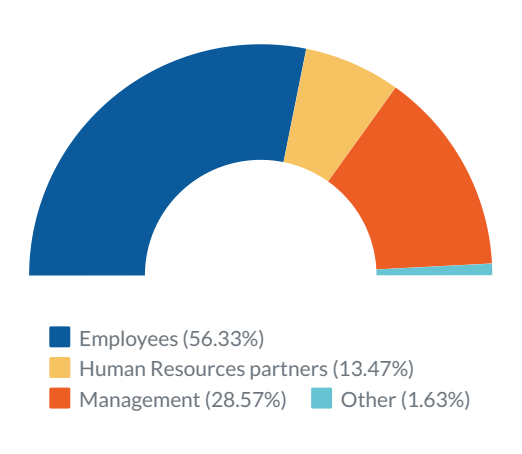
Long description
Who requested a consultation?
Employees account for 56.33% of consultation requests.
Human resources partners account for 13.47% of consultation requests.
Management accounts for 28.57% of consultation requests.
1.63% of requests come from other sources.
Most popular consultation topics
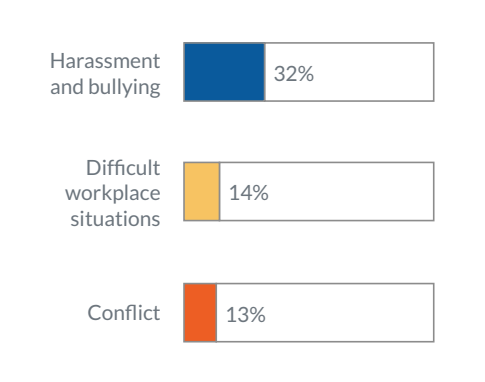
Long description
Most popular consultation topics
Harassment, bullying, difficult workplace situations and conflict are the most popular consultation topics.
Harassment and bullying topics account for 32% of consultation topics.
Difficult workplace situations topic accounts for 14% of the consultation topics.
Conflict topic accounts for 13% of the consultation topics.
Workplace Initiatives Program
The HCE continues to develop its workplace restoration program to assist teams that may have been affected by a harassment complaint or where there have been several conflicts of different natures. The HCE works in close collaboration with its partners to:
- identify workplaces in need of assistance and support;
- develop integrated intervention strategies to support teams;
- develop and implement action plans including personalized activities that address the issues identified.
In the 2019-2020 fiscal year: 30 Restoration files
- 13 cases stemming from harassment complaints
- 17 cases stemming from consultation files
Harassment Complaint Resolution Program
The harassment complaint resolution team manages harassment-related situations - with or without a formal complaint. The graphs that follow provide an overview of the formal complaints filed in 2018-2019. When we compare the number of complaints to the number of ESDC employees who reported experiencing workplace harassment in the last 12 months in the 2018 Public Service Employee Survey (13%), it is clear that the majority of victims are not coming forward. We are committed to seeing this change and will continue our efforts to raise awareness and support and equip employees to speak up.
In fiscal year 2018-2019, we received: 76 Complaints
Status of complaints as of March 31, 2019
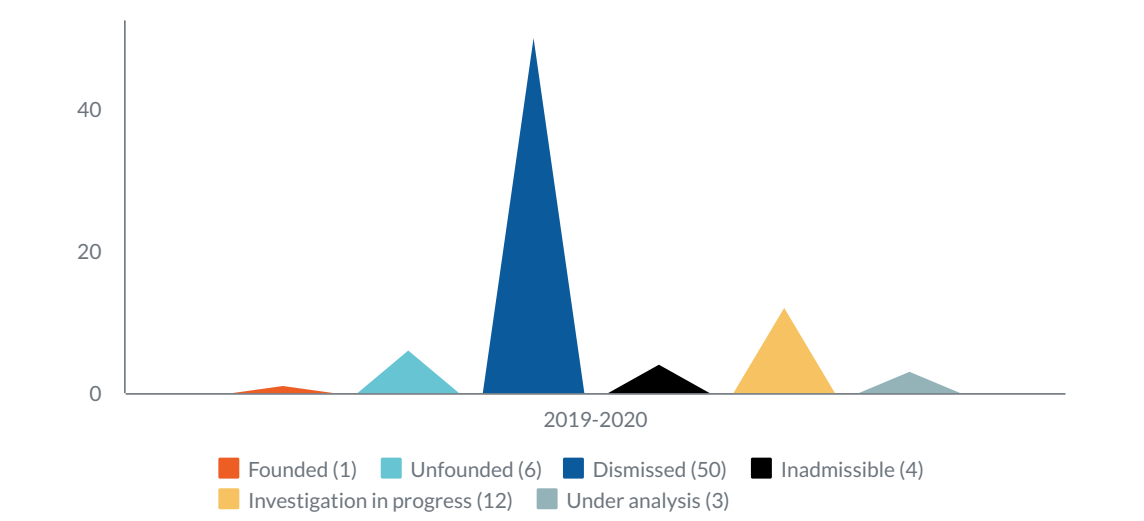
*Type of harassment involved in founded complaint: Sexual harassment
Long description
Status of complaints as of March 31, 2019
- Founded:
- The investigation concluded that the harassment described in the complaint was founded (1);
- Not founded:
- The investigation concluded that the harassment described in the complaint was unfounded (6);
- Dismissed:
- An analysis concluded that the harassment described in the complaint did not meet the definition of harassment issued by the Treasury Board of Canada Secretariat (TBS) (50);
- Inadmissible:
- The complaint did not meet the time limit prescribed in the TBS policy (complaints must be submitted within 12 months of the last harassment incident) or was withdrawn by the complainant (4);
- Under investigation:
- At the end of fiscal year 2018-2019, the complaint was still under investigation and no decision had been reached (12); and
- Under analysis:
- The advisor was in the process of analyzing the complaint to determine if it met the TBS definition of harassment (3).
Information about dismissed complaints:
We found that the harassment awareness and prevention campaign encouraged many employees in difficult situations at work to speak up and report them. We see that our "Speak Up" slogan has had a positive impact. Our goal is to help address all situations, from incivility to harassment or violence. Although some of the complaints filed this year did not meet the TBS definition of harassment, they were all managed and resolved in the best manner possible. Even if a complaint is dismissed, the advisors work with the parties involved and management to find the most appropriate solution in each situation. For example, advisors may refer the parties to the Workplace Restoration Program or the Office of Informal Conflict Management.
Who made the allegations against whom?
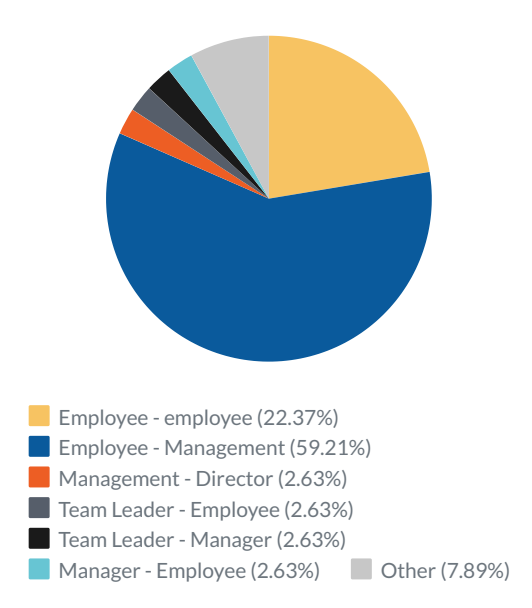
Long description
Who made the allegations against whom?
- Employee – Employee:
- Allegation involving an employee towards another employee (22.37%).
- Employee – Management:
- Allegation impliquant un employé envers la gestion (59.21%).
- Management – Director:
- Allegation involving a manager towards a director (2.63%).
- Team Leader – Employee:
- Allegation involving a team leader towards an employee (2.63%).
- Team Leader – Manager:
- Allegation involving a team leader towards a manager (2.63%).
- Manager – Employee:
- Allegation involving a manager towards an employee (2.63%).
- Other:
- Type of claim involving other parties (7.89%).
Types of allegations filed
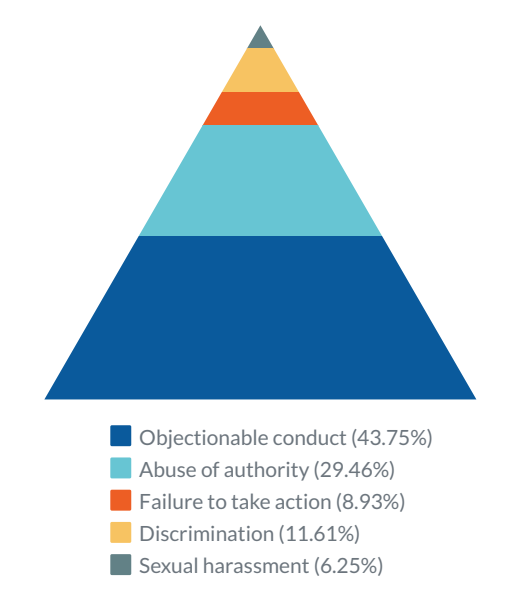
Long description
Types of allegations filed
Objectionable conduct allegation type accounts for 43.75% of the allegations.
Abuse of authority allegation type accounts for 29.46% of the allegations.
Failure to take action allegation type accounts for 8.93% of allegations.
Discrimination allegation type accounts for 11.61% of the allegations.
Sexual harassment allegation type accounts for 6.25% of the allegations.
Information about complaints with "Investigation in Progress" status in 2018-2019
In the 2018-2019 report, 11 complaints were still under investigation as of March 31, 2019. What happened to these complaints?
- 6 founded complaints
- 3 unfounded complaints
- 2 complaints still under investigation*
* Usually, complaints are resolved within 12 months of their submission in accordance with the TBS Policy on Harassment Prevention and Resolution. However, investigations sometimes take longer for reasons beyond our control, such as the availability of investigators, parties and witnesses.
Consequences
At ESDC, no reported situation is overlooked. Founded cases are managed through appropriate corrective and disciplinary action. Action taken can include coaching, oral and written reprimands, suspension, demotion, deployment without consent and termination of employment, where warranted. Management is responsible for ensuring that discipline is corrective, not punitive. When managers select appropriate disciplinary action, they review each situation individually, considering various factors, such as aggravating and mitigating factors, disciplinary history and relevant case law.
Outcomes for the 6 founded complaints still under investigation in the 2018-2019 report:
- These cases involved multiple complainants against two respondents. Both respondents were no longer employed by the federal public service following the investigation.
Outcome of the founded complaint in 2019-2020 :
- The disciplinary process is still in progress and no decision has been made.
What we noticed…
The number of complaints continues to increase each year, which could indicate that more people feel comfortable about reporting harassment situations and know where to turn for help.
Trends over the past three years:
- The most frequently reported type of harassment is objectionable acts (such as belittling, bullying or mocking someone); and
- The most frequently observed type of harassment among founded complaints is sexual harassment.
What’s ahead…
Bill C-65
- New legislation under Bill C-65 will be implemented on January 1, 2021. The harassment complaint resolution process will be combined with the violence complaint resolution process to form a single process under the Canada Labour Code. Starting in 2020-2021, the HCE will handle all complaints of violence in collaboration with Occupational Health and Safety (OHS). Our department has already begun the preparatory work. Since April 2019, complaints of violence requiring investigation have been transferred to the HCE.
- In fiscal year 2019-2020, the department received 9 complaints of violence.
- Mandatory training for employees and managers will be developed and rolled out across the department.
Prevention
The HCE and its partners continue to promote respect in the workplace through the awareness and prevention campaign. Several products, resources and tools are planned for the 2020-2021 fiscal year:
- Products that address the need for education on the difference between harassment and performance management or interpersonal conflict;
- Blogs and images about "what harassment is not";
- Facilitator guides for posters on the more subtle forms of harassment; and
- Products geared to our new telework reality.
